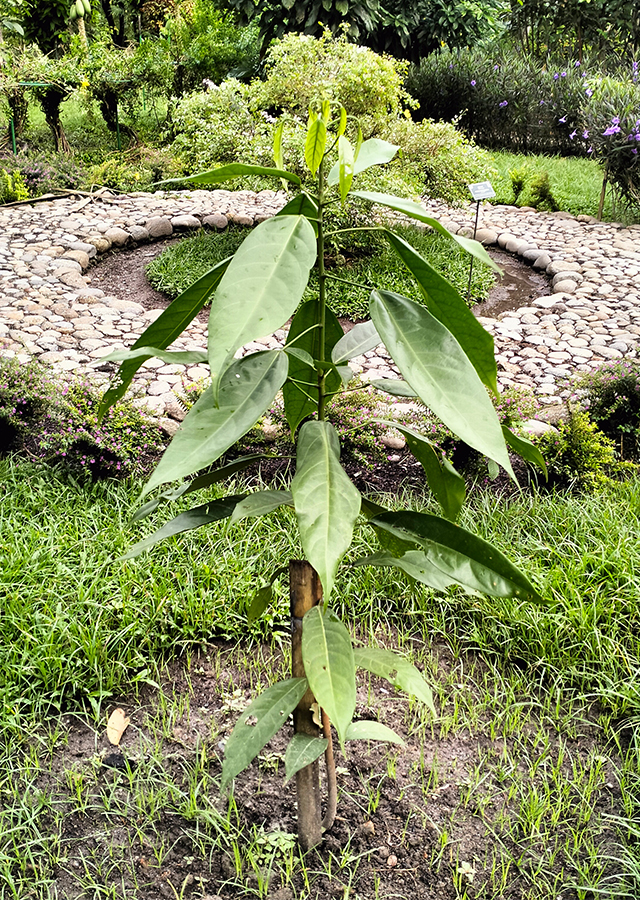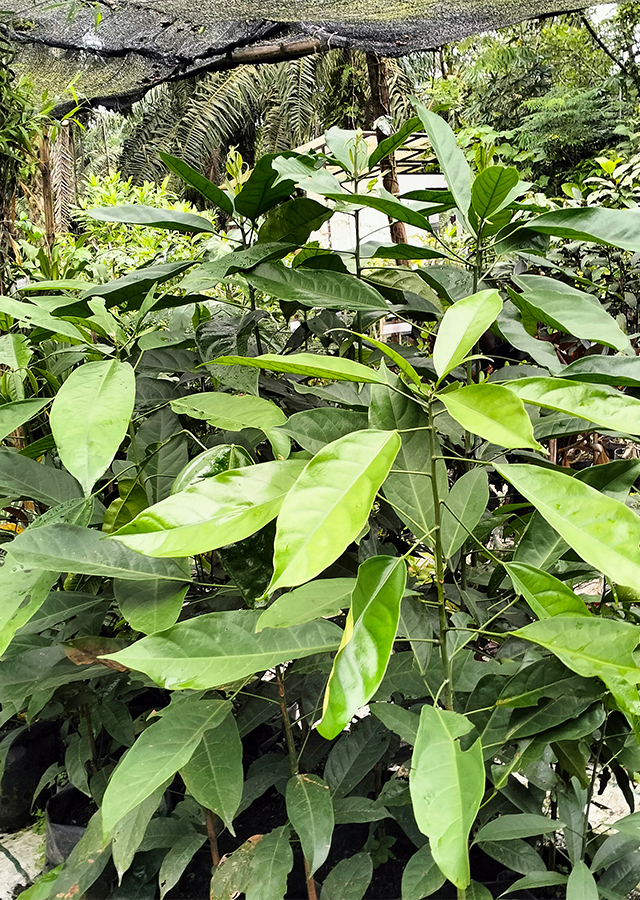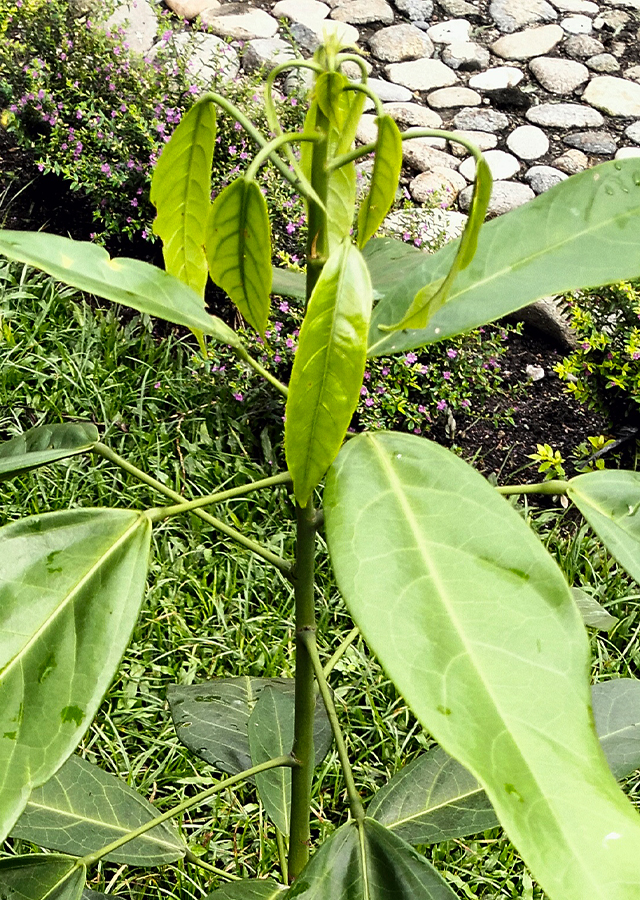Kola Nut
Cola nitida (Vent.) Schott & Endl.
Malvaceae
Location in our garden
Orchard



Synonym
Bichea nitida (Vent.) Farw.
Braxipis nitida (Vent.) Raf.
Sterculia nitida Vent.
Habitus
Trees. Medium-sized tree, about 8-12 m tall, but can reach 27 m
Part Used
Seeds
Bark
Fruit
Sap
Growing Requirements
Full Sunshine
Habitat
Forest
Overview
Cola nitida or kola nut is native to West Africa and Sudan. Grows wild in the Ivory Coast and Liberia, also planted from Sierra Leone to Gabon. This plant entered Indonesia in the early 10th century. African peoples have long used C. nitida for various purposes for religious rituals and ceremonial activities, such as weddings, naming children, burials, and sacrifices to the gods of African mythology. Conventionally, C. nitida is also used in tropical Africa for the treatment of all kinds of diseases and has been widely consumed as a stimulant since ancient times. The edible seeds of the kola nut and extracts have been used in the food and beverage industry as a flavor enhancer, and have been used as an original ingredient in the manufacture of the soft drink Coca-Cola. In addition, kola seeds can be used in jam production due to their high pectin content, they are also often used as a substitute for coffee. Kola seed is registered with the U.S. Food and Drug Administration (FDA) and declared as a food ingredient that is safe for human consumption and classified as a natural food spice or flavor enhancer. The FDA has also approved kola seed extract as an inactive ingredient in certain medications. The red color of the kola seed is also a potential source of food coloring. C. nitida wood is widely used by the community as a material in the manufacture of furniture, houses, ships, dishes, but the wood is vulnerable to borers. C. nitida also functions as a shade tree on cocoa plantations.
Vernacular Names
No data found on this. Need further research.
Agroecology
C. nitida is a tropical plant in hot, humid, tropical lowland forests and is usually found growing at altitudes up to 300 m asl, but is also found up to 800 m asl, with an average annual rainfall in the range of 1,400 - 2,500 mm, but tolerates 1200 - 3500 mm and can survive for 3 months or more in the dry season. Thrives in heavy or light soils as long as the soil is deep, well drained, contains lots of humus, and is positioned in full sun, while young trees need shade. C. nitida can grow in soils with pH in the range of 5 - 6, but tolerates 4.3 - 7. It grows best in areas where the annual daytime temperature is in the range of 21 - 30 °C, but can tolerate 10 - 35 °C. The plant is drought tolerant, and can be cultivated in drier areas as long as groundwater is available.
Morphology
- Stems - round, sometimes straight, up to 1.5 m in diameter, may be branchless for several meters. The bark is cracked and grayish-brown with rough outlines, but the small branches are smooth.
- Leaves - simple, single, green, deep veined, smooth surface, elliptical in shape with entire leaf margin flat and leaf tip tapered. The leaves have an alternate leaf arrangement (leaves appear singly on alternate sides of a branch).
- Flowers - greenish-yellow or white with purple and red stripes and margins within. The flowers form short, irregular clusters, forming a cup.
- Fruits - light green, dry fruit has a wrinkled, uneven texture and curved ridges that run the length of the pod. The fruit consists of 5 backward-curved cells, and contains about 10 seeds per fruit. They split in half to release the seeds.
- Seeds - irregular, large, cream to reddish brown, aromatic.
Cultivation
- Propagated by seeds. To encourage germination, soak the seeds in water for 24 hours before planting and place in a warm location (about 29°C). Germination is slow, takes 2 - 3 months, but can be achieved in 10 - 18 days when the seeds are sown at 30 °C. Plants begin to produce seed pods at around 7 years of age.
Chemical Constituents
Alkaloids, saponins, tannins, cardenolida, proanthocyanidins, methylxanthin (caffeine and theobromine), catechins, theophylline, cholatin, phlobaphene, anthocyanins, flavanoids.
Traditional Medicinal Uses
- Used for short-term relief of fatigue, depression, chronic fatigue syndrome (CFS), melancholy, lack of normal muscle tone (atony), exhaustion, dysentery, a type of diarrhea called atonic diarrhea, weight loss, and migraine headaches.
Part Used
Reference Sources
- Royal Botanic Gardens. Plants of the World Online: Cola nitida (Vent.) Schott & Endl.. https://powo.science.kew.org/taxon/urn:lsid:ipni.org:names:822755-1. 06-01-23.
- Flora Fauna Web. 2022. Cola nitida. https://www.nparks.gov.sg/florafaunaweb/flora/2/8/2822. 06-01-23.
- Adeosun O.I., Olaniyi K. S., Amusa O. A., Jimoh G. Z., Oniyide A. A. 2017. Methanolic extract of Cola nitida elicits dose-dependent diuretic, natriuretic and kaliuretic activities without causing electrolyte impairment, hepatotoxicity and nephrotoxicity in rats. International Journal of Physiology, Pathophysiology and Pharmacology. 9(6): 231–239. https://www.ncbi.nlm.nih.gov/pmc/articles/PMC5770520/.
- Plants For A Future. 2022. Cola nitida - (Vent.) Schott & Endl.. https://pfaf.org/user/Plant.aspx?LatinName=Cola+nitida. 06-01-23.
- RxList. Cola Nut Health Benefit. 2021. Cola nitida. https://www.rxlist.com/cola_nut/supplements.htm.

